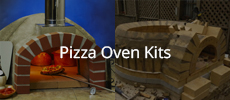Re: Crack
IFB'S are good insulators, but won't act too well as an expansion joint because they don't compress.
X
-
Re: Crack
Heres my heat break made of insulating fire bricks. 1 Photo
1 Photo
Leave a comment:
-
Re: Crack
Yes actually it's not really getting hot, but it definitely didn't show until that first big fire. It is just a hairline, barely 1mm
Leave a comment:
-
Re: Crack
Never seen a problem there. Mine is always cool enough to touch as the gasses have escaped up the vent. Since the brick doesn't conduct heat very well I think something else is contributing to the crack (bad masonry, shifting of the base...)1 Photo
Leave a comment:
-
Re: Crack
Yes, that is the point. The outside of the arch is at ambient while the inside of it is getting hot. It is similar to an uninsulated flue tile which is likely to crack because one side is hot while the other side remains cool. Lots of ovens,Rado's from traditional oven and mine as well as many others are built this way. I meant between the outer decorative arch and the entry, but on both sides of the entry like Chip's is probably even better.Originally posted by Les View PostWho has done that? The decorative arch is pretty much sitting at ambient temperature. Do you mean the dome and the vent/entry?
Do you mean the dome and the vent/entry?
Leave a comment:
-
Re: Crack
I for one, have heat breaks at both ends of the flue arch. I know there are others out there.Originally posted by Les View PostWho has done that? The decorative arch is pretty much sitting at ambient temperature. Do you mean the dome and the vent/entry?
Do you mean the dome and the vent/entry?
Leave a comment:
-
Re: Crack
Who has done that? The decorative arch is pretty much sitting at ambient temperature.Originally posted by david s View Posteliminated if the design incorporates an expansion joint/ heatbreak between the decorative arch and the inner oven parts. Do you mean the dome and the vent/entry?
Do you mean the dome and the vent/entry?
Leave a comment:
-
Re: Crack
Cracks in the outer decorative arch are not unusual in many builds. They are caused by a high difference in temp between the inner and outer surfaces of the arch's bricks, resulting in uneven thermal expansion. In addition actual expansion from the inner parts of the oven can also create physical outward pressure on the arch. Both conditions are reduced and cracks in the arch pretty much eliminated if the design incorporates an expansion joint/ heatbreak between the decorative arch and the inner oven parts.
Leave a comment:
-
Re: Crack
I would not say anything, but the last statement pushes on of my buttons. Mortar and concrete are not the same thing. They do not share the same functions, only some of the same ingredients.
Normally with concrete you want the strongest concrete that is practical. This is NOT true with mortar. When doing a mix design for a mortar, you want the WEAKEST mortar that will suffice.
Concrete: High compressive and tensile strength.
Mortar: Weaker than the units being laid, high bond strength and flexural strength.
Leave a comment:
-
Re: Crack
As with any portland cement based mortar or concrete mix, it will cure harder if you keep it wet/damp while it is curing (try to keep it damp for at least 3-5 days).
Leave a comment:
-
Re: Crack
I think I just left it till the next firing which was probably a week or so.Originally posted by Filthymutt View PostOk thanks. It's as you said, if I just leave it be it is going to bug me forever. I think I will try your method and hope for the best. After you did that, how long did you wait, curing time, for your next firing?
Bob
Leave a comment:
-
Re: Crack
I also filled my small cracks - a few came back (but smaller than they were) and some never re-appeared. After that I stopped worrying about them and have had no issues!
Leave a comment:
-
Re: Crack
Ok thanks. It's as you said, if I just leave it be it is going to bug me forever. I think I will try your method and hope for the best. After you did that, how long did you wait, curing time, for your next firing?Originally posted by brickie in oz View PostI got a very small hairline crack in mine when I first fired it, while its not a problem structurally it bugged the hell out of me.
I racked out the joint to a depth of 5mm, moistened the joint and refilled it, it hasnt reappeared.
Bob
Leave a comment:






Leave a comment: